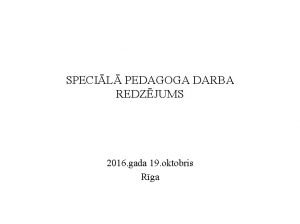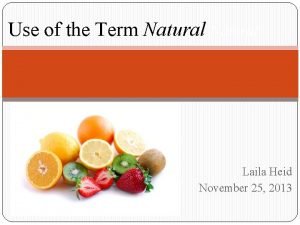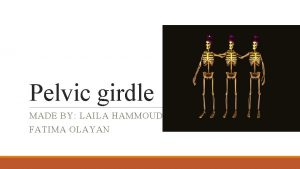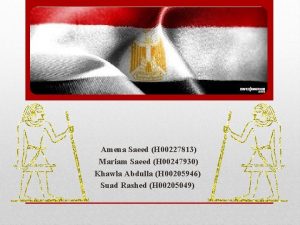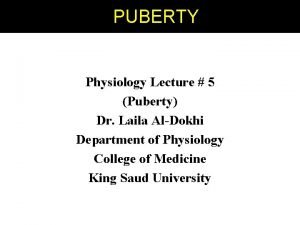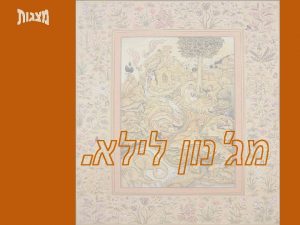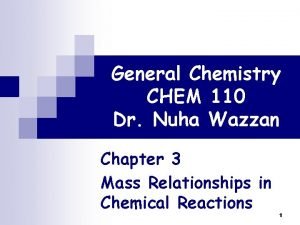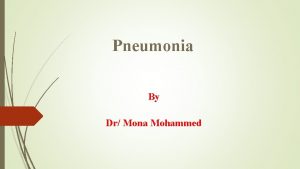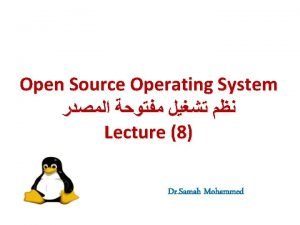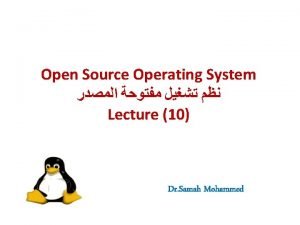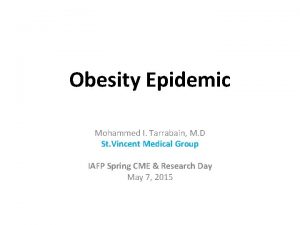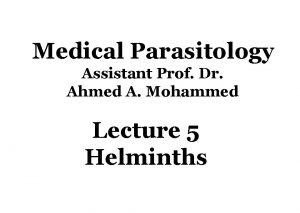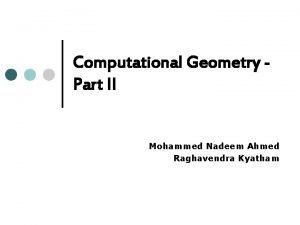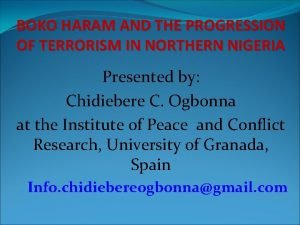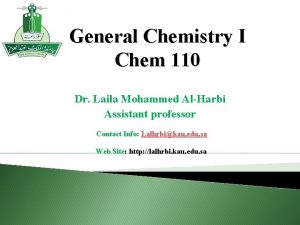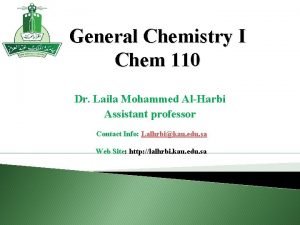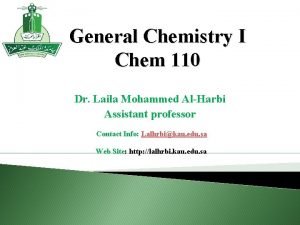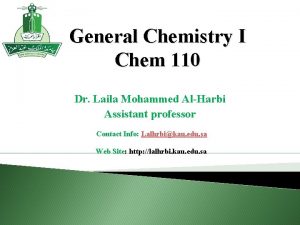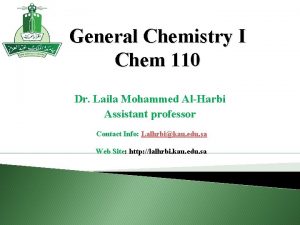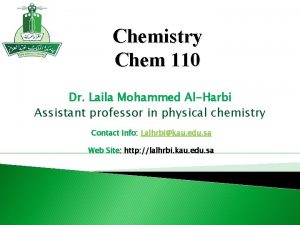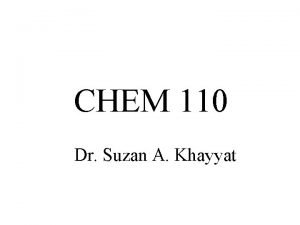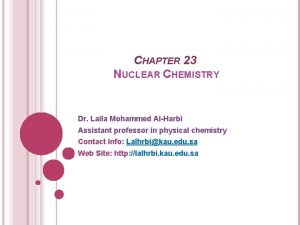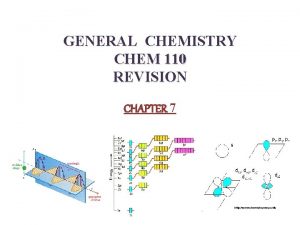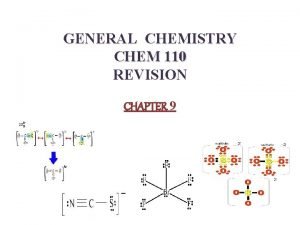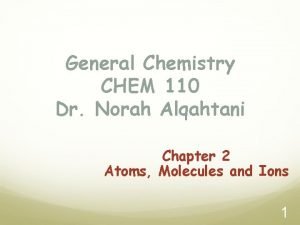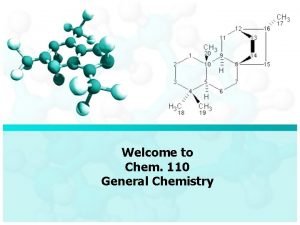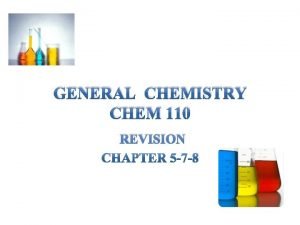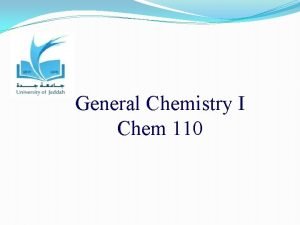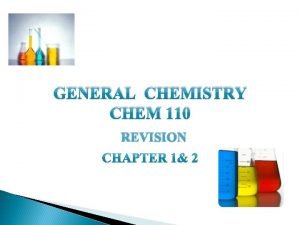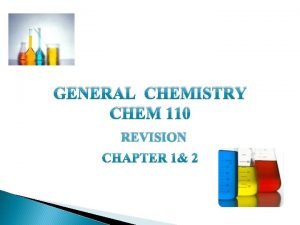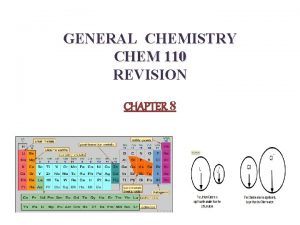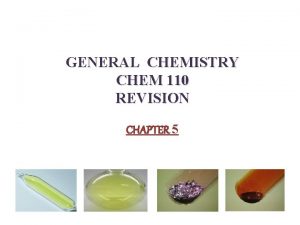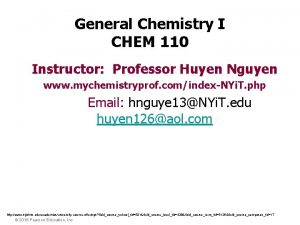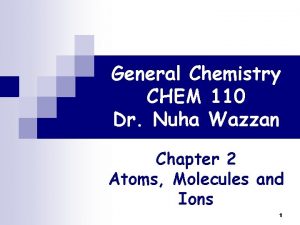General Chemistry I Chem 110 Dr Laila Mohammed






















![Temperature Scales � Fahrenheit °F →°F = [ (9/5) × °C] + 32 � Temperature Scales � Fahrenheit °F →°F = [ (9/5) × °C] + 32 �](https://slidetodoc.com/presentation_image_h2/3624ac96caad3cef8328919f8cb18e10/image-23.jpg)


- Slides: 25

General Chemistry I Chem 110 Dr. Laila Mohammed Al-Harbi Assistant professor Contact Info: Lalhrbi@kau. edu. sa Web Site: http: //lalhrbi. kau. edu. sa

CHEM 110 1 Course No. Course Title Chem 110 General Chemistry I No. of Units Th. Pr. Credit 3 3 Pre-requisites - Course Objectives: The course aims to introduce students to basic knowledge and principle in chemistry. Course Description : It provides an introduction to the general principles of chemistry for students planning a professional career in chemistry, a related science, the health professions, or engineering. By the end of this course the student will be able to understand the following: Significant figures, scientific notation and units, stoichiometry, atomic structure & periodic table, chemical bonding, gases, ionic equilibrium, basic principles of organic and basic principles of biochemistry. Main text books: § Chemistry, by Chang, 10 th. ed. , 2007, Mc. Graw-Hill. § Chemistry, by Steven S. Zumdahl, 6 th ed. , Houghton Mifflin College Div. Subsidiary books : Chemistry, by Mortimer, 6 th ed. , Wadsworth Inc. Dr. LAILA AL-HARBI

CHEM 110 Main text book : § Chemistry, by Chang, 10 th. ed. , 2007, Mc. Graw. Hill. Dr. LAILA AL-HARBI

Chapter 1 The study of change Measurement SI units Mass and weight Volume Temperature scales � 1 -7 v v Ø Homework Page 33 1. 17, 1. 19, 1. 22, 1. 23, 1. 25, 1. 26. Dr. LAILA AL-HARBI

Objectives � By the end of this chapter you should: � Know the 7 SI basic units and their prefixes. � Be able to convert from one unit to other. � Know to derive units from the 7 SI basic units. � Know the temperature Scales. Dr. LAILA AL-HARBI

Introduction � Chemistry is the study of matter and the changes it undergoes � There are three states of matter gas liquid solid Dr. LAILA AL-HARBI

1. 7 Measurement and Units The International System of units (SI Units) � used for commerce and science around the world Dr. LAILA AL-HARBI

1 m Dr. LAILA AL-HARBI

A measurement system is a set of units which can be used to specify anything which can be measured. This mean 1 Tm= 1 x 1012 m so x Tm= 1 m 1 m= 1 x 1/ 1 x 1012 1 m = 1 x 10 -12 To make this calculation 1 x 1012 In calculator press 1 then exp then – then 12 not 1 then x then 10 then exp then – then 12 Dr. LAILA AL-HARBI It can be used to any SI units i. e. , 1 Tg = 1 x 1012 g 1 Ts = 1 x 1012 s

Examples � The SI unit of mass is � (a). The pound � (b). The gram � (c). The kilogram � (d). The mole. The SI prefixes giga and micro represent, respectively: � A. 10 -9 and 10 -6. � B. 106 and 10 -3. � C. 103 and 10 -3. � D. 109 and 10 -6. � Dr. LAILA AL-HARBI

How many microseconds are in a second? (a). 1 x 10 -1 1 µs= 1 x 10 -6 s -6 (b). 1 x 10 x µs = 1 s (c). 1 x 10 -15 (d). 1 x 10 6 Explanation: Since the prefix micro means 1 x 10 -6, there will be 1 x 10 + 6 microseconds in one second. Dr. LAILA AL-HARBI

Example � Which � (a) � (b) � (c) � (d) of the following is the smallest distance? 21 m → 21 m 2. 1 x 102 cm → 2. 1 m 21 mm → 0. 021 m 2. 1 x 104 pm → 2. 1 x 10 -8 m Put all of them in the same unit � Explanation: Even though 2. 1 x 104 is the largest number in this question, the units of pm (picometers) are the smallest units here, making it the smallest distance. Dr. LAILA AL-HARBI

� A) 6. 0 km is how many micrometers? � Solution 1 1 km = 103 m 6 km = x = 6 × 103 m 1µm = 1× 10 -6 m x = 6 × 103 m x = 6 × 109µm Explanation: convert first to meter then from meter to micro ( two steps solution ) Dr. LAILA AL-HARBI

� Solution 2 1 km = 103 m � → 1 m = 10 -3 km � 1µm = 1× 10 -9 m � → 1 m = 106µm � 10 -3 km = 106µm � 6 km = x � � � X = 6 × 106 µm/ 10 -3 km = x = 6 × 109µm Explanation: make direct relation ship between kilometer and micrometer ( one step solution ) Dr. LAILA AL-HARBI

� Example diameter of an atom is approximately 1 10 -7 mm. What is this diameter when expressed in nanometers? � Example � The 1 10 -18 nm � B. 1 10 -15 nm � C. 1 10 -9 nm � D. 1 10 -1 nm � A. �= 1× 10 -7 × 106 = � 1 × 10 -1 nm = 0. 1 nm � Which of these quantities represents the largest mass? � A. 2. 0 102 mg � B. 0. 0010 kg � C. 1. 0 105 g � D. 2. 0 102 cg � Put all of them in the same unit A) 0. 2 g B)1 g C) 0. 1 g D) 2 g Dr. LAILA AL-HARBI

Mass and Weight � Mass is the measure of the amount of matter in an object. SI unit of mass is the kilogram (kg) 1 kg = 1000 g = 1 x 103 g � Weight is the measurement of the pull of gravity on an object. weight = c x mass The Mass of an object doesn't change when an object's location changes. Weight, on the other hand does change The weight of man on earth is 50 pounds. with location. is 8. 25 pounds on moon � Chemist are interested primarily in mass � Dr. LAILA AL-HARBI

SI derived units are defined in terms of the seven base quantities via a system of quantity equations. � The SI derived units for these derived quantities are obtained from these equations and the seven SI base units. For example � Area = width x length � Unit of width = m � Unit of length = m � Unit of Area = m× m = m 2 � Dr. LAILA AL-HARBI

Volume – Volume = width × length × hieghst = m × m = m 3 SI derived unit for volume is cubic meter (m 3) Common unit of volume is liter (L) and milliliter (ml) The relation ship between liter (L) and ml (1 L= 1000 m. L) The relation ship between liter (L) and metric system 1 L = 1 dm 3 The relation ship between milliliter (ml) and metric system 1 m. L = 1 cm 3 1 dm 3 = (1 x 10 -1 m)3 = 1 x 10 -3 m 3 1 cm 3 = (1 x 10 -2 m)3 = 1 x 10 -6 m 3 Dr. LAILA AL-HARBI

Examples � The diameter of an atom is approximately 1 10 -7 mm. What is this diameter when expressed in nanometers? 1 10 -18 nm � B. 1 10 -15 nm � C. 1 10 -9 nm � D. 1 10 -1 nm � A. � How many cubic centimeters are there in exactly one cubic meter? 1 10 -6 cm 3 � B. 1 10 -3 cm 3 � C. 1 10 -2 cm 3 � D. 1 106 cm 3 � Solution � (1 m )3 = (1 10 -2 cm )3 � 1 m 3 = 1 10 -6 cm 3 � A. Dr. LAILA AL-HARBI

Density is defined as the amount of matter in a given amount of space. density = mass volume d = m/V § SI derived unit for density is kg/m 3 § 1 g/cm 3 = 1 g/m. L = 1000 kg/m 3 § Density is intensive property Density decrease with temperature Unit of density is Kg/L g/ml )g/cm 3 for liquid and solids g/L = 0. 001 g/ml for gases Because density of gases are very low § § § The density of copper is 8. 94 g/cm 3. Dr. LAILA AL-HARBI

Example 1. 1 �A piece of Gold metal has a volume of 15. 6 cm 3, with a mass of 301 g What is its density? m d= V 301 g/ 15. 6 cm 3 = 19. 3 g/ cm 3 �A piece of platinum metal with a density of 21. 5 g/cm 3 has a volume of 4. 49 cm 3. What is its mass? m d= V m=dx. V = 21. 5 g/cm 3 x 4. 49 cm 3 = 96. 5 g Dr. LAILA AL-HARBI

Example 1. 2 � The density of mercury is 13. 6 g/m. L has a volume of 5. 50 m. L. What is its mass? m d= V m=dx. V = 13. 6 g/m. L x 5. 50 m. L = 74. 8 g � The density of sulfuric acid is 1. 41 g/m. L has a volume of 242 m. L. What is its mass? m d= V m=dx. V = 1. 41 g/m. L x 242 m. L = 341. 22 g Dr. LAILA AL-HARBI
![Temperature Scales Fahrenheit F F 95 C 32 Temperature Scales � Fahrenheit °F →°F = [ (9/5) × °C] + 32 �](https://slidetodoc.com/presentation_image_h2/3624ac96caad3cef8328919f8cb18e10/image-23.jpg)
Temperature Scales � Fahrenheit °F →°F = [ (9/5) × °C] + 32 � Celsius °C → °C = (5/9) (°F - 32) � Kelvin ° K → ° K = °C + 273. 15 Dr. LAILA AL-HARBI

Example 1. 3 � Convert 224 0 C to degrees Fahrenheit? � °F = (9 0 F /5 0 C) × °C + 32 � [°F = (9 0 F /5 0 C) × 224 °C] + 32 0 C = 435 0 F � Convert -452 0 F to degrees Celsius. � °C = (5 0 C /9 0 F) (°F - 32 0 F) � °C = (5 0 C /9 0 F) (-452 °F - 32 0 F) = -269 0 C � Convert -38. 9 0 C to degrees Kelvin. . � ° K = [-38. 9 °C + 273. 15 °C ] × 1 K/ 1 0 C = 234. 3 K Dr. LAILA AL-HARBI

Ammonia boils at -33. 4 C. What temperature is this in F? � A. -60. 1 F � B. -92. 1 F � C. -28. 1 F � D. +13. 5 F � F = (9 0 F /5 0 C) × °C + 32 [°F = (9 0 F /5 0 C) × -33. 4 °C] + 32 0 C = 435 0 F Dr. LAILA AL-HARBI
 Numero niss
Numero niss 110 000 110 111 000 111
110 000 110 111 000 111 Laila henzele
Laila henzele Laila knio
Laila knio Laila hussein
Laila hussein Laila heid
Laila heid Laila hammoud
Laila hammoud Laila mourad
Laila mourad Laila medin
Laila medin Laila loste
Laila loste Laila
Laila Layla and majnun sparknotes
Layla and majnun sparknotes How to find one mole of a compound
How to find one mole of a compound Rahaf mohammed video
Rahaf mohammed video Nadia mohammed
Nadia mohammed Mohammed mona md
Mohammed mona md Dr samah mohammed
Dr samah mohammed Dr samah mohammed
Dr samah mohammed Dr mohammed tarrabain
Dr mohammed tarrabain Mohammed al kamali
Mohammed al kamali Dr mohammed ahmed
Dr mohammed ahmed Prophet soliman
Prophet soliman Dr mohammed ahmed
Dr mohammed ahmed Mohammed yusuf (boko haram)
Mohammed yusuf (boko haram) Dr mohammed shaker
Dr mohammed shaker Dr aleem mohammed
Dr aleem mohammed


